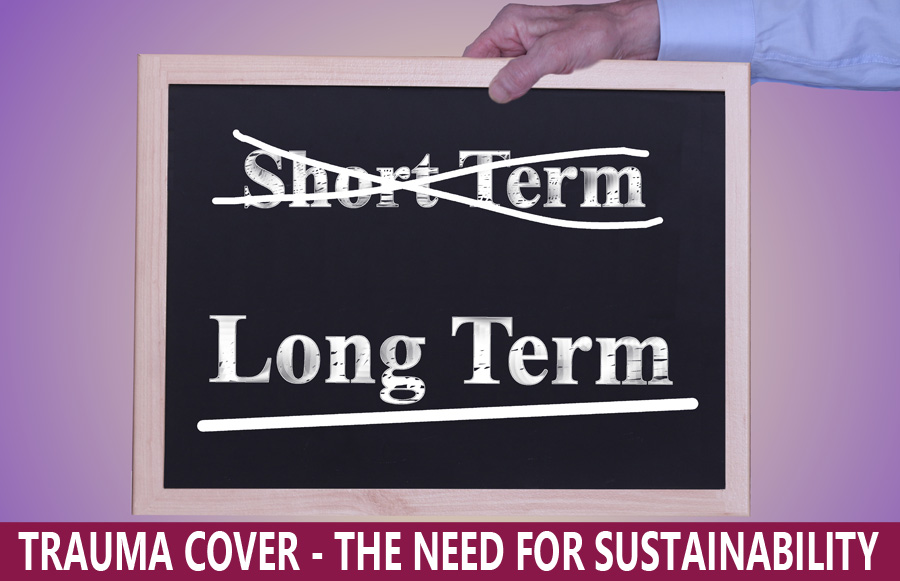CHRISISMS
A fortnightly pearl of wisdom to fast track your success
CHRISISM #64 - Trauma Cover - The Need for Sustainability
24 April 2018
Are you still trying to get Trauma Cover over the line with the cheaper option of stepped premiums for your clients?
As you will know from Chrisism#33, I used to recommend stepped premiums for Trauma Cover until I had my ‘lightbulb moment’ in 2007, but since then I have always recommended level premiums for Trauma Cover to clients of all ages, and where cost becomes an issue we simply move to a discussion around a split mode of premium payment. Using my methodology, there is a very logical way of splitting your client’s Trauma Cover between stepped and level premiums. All we need to do is to identify what amount of Trauma Cover is required for the long term and how much is more of a short term requirement. Assuming a client has a non deductible mortgage, then the calculation for Trauma Cover is 10 x the annual income shortfall left after the annualised IP benefit + the amount of the outstanding mortgage. The 10 x income shortfall is the long term requirement (and therefore the priority for level premium) as it is designed to run alongside the income protection benefit all the way to age 65, whereas the amount of the outstanding mortgage will be coming down over time and therefore it would make sense to exercise a manual premium freeze when the stepped premium starts to become unaffordable, and this would mean that the Trauma Cover sum assured could reduce pretty much in line with the outstanding mortgage. We need to make sure that our clients understand that the way in which they get the maximum potential benefit out of Trauma Cover is to own it for as long as possible. Unfortunately, in this country at the moment the average age at which people typically buy Trauma Cover is in their mid 30s (because there is the greatest perceived need at this age and the cover is still very affordable), and then the average age at which people typically give it away is in their mid 40s (because the stepped premium is becoming unaffordable). Ironically, this ten year period between 35 and 45 is probably statistically the ten year period of an adult’s life during which you are least likely to suffer a “trauma”, as under the age of 35 you are more likely to suffer an accident related ‘trauma’ and over the age of 45 is when the clock starts ticking ever louder around the “Big Four”! So just a couple of things I think you should be sharing with your clients, firstly with those under the age of 35 and secondly with those in their early 40s:- Having shared the irresistible combination concept (see Chrisism#14) with your younger clients, you need to show them the cumulative stepped vs level premium projection focusing on the issue of maximum outlay to age 65/70 vs likely return. As an example, on a sum assured of $400,000 to age 65, this might be the difference between a cumulative outlay of $45,000 on a level premium and $158,000 on a stepped premium. Oh and by the way, the difference in premium day one between stepped and level in this example is about $11 per week! After I had my ‘lightbulb moment’ back in 2007, I had to go back to all of my existing clients who had stepped premiums and try and convert them to level premiums – and I’m happy to say that every single client to whom I presented my argument converted at least some of their Trauma Cover to level premium. I believe one of the most compelling aspects of the recommended strategy in the SOA was when I showed them what was going to happen to their stepped premium between their age now (early 40s) and age 65 and it was as follows:- by the age of 50 it would be approximately triple the current premium, at age 55 it would be 5 x the current premium, by age 60 it would be 9 x the current premium and by age 64 it would be 15 x the current premium. Enough said?! I hope you have success going back to existing clients who currently have “short term” Trauma Cover and converting them to “long term” Trauma Cover, and then when their stepped premium becomes more expensive than their level premium (maybe 7 or 8 years’ time), you can take great pleasure in contacting them on every policy anniversary and detailing for them the value you represent in dollar definable terms. |





